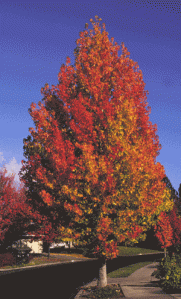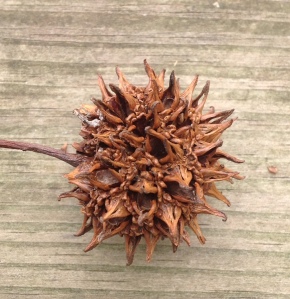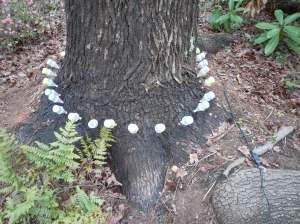The Sweet Gum Tree
A forty foot tall Sweet Gum tree rises from the northeast corner of my back yard. On this early spring day, the tree is still a skeleton, although leaf buds are just beginning to emerge and dozens of Sweet Gum balls dangle from its naked branches like shriveled Christmas tree ornaments. Hundreds more lie scattered throughout the grass, and spill out onto the alleyway asphalt, where most are flattened by car wheels. In a few weeks, the Sweet Gum’s glossy green leaves–five pointed stars–will emerge. Then a new crop of gumballs, green throughout the summer, but gradually drying out to become spiky brown seed-carrying hulls. The finches, nuthatches and chickadees will then begin pressing their small beaks into the Sweet Gum balls’ many chambers, extracting the two edible seeds that each chamber contains. Larger bird species with beaks too large to get to the seeds leave these to their smaller competitors. In the fall the Sweet Gum’s leaves will turn yellow, then purple, then red, and will be among the last of the leaves in my yard to drop. One by one, from late fall steadily through the winter, most of the dried out gum balls, long since deprived of their seeds, will drop from the Sweet Gum’s branches.
Liquidambar styraciflua gets its name from the resin the tree produces. It was used to add a distinctive balsamic flavoring to the first pipe of tobacco Aztec Emperor Moctezuma shared with Conquistador Hernando Cortez. Spanish physician and New World explorer Francisco Hernandez became an early convert to its value, claiming it had a range of healing properties. He claimed it was effective in treating gonorrhea and diptheria, was a pain reliever and a sleep aid, and that it “relieve[d] wind in the stomach.” In some parts of the American South, where the tree is abundant, locals call it Alligator Wood because its furrowed and scaly bark resembles the skin of that southern reptile.
My southeastern Ohio yard is near the northern edge of the Sweet Gum’s natural range. This is a southern tree, and in warmer climates, undisturbed, the tree can reach heights of one hundred or more feet high. Mine has probably reached its peak height, and its natural conical symmetry has been compromised by the regular hair cuts it has received from American Electric Power crews determined to keep its east-reaching branches out of the power lines which run along the edge of my property. My house was built in 1962, by Dr. William and Beatrice Fisk, and while this tree might have preceded the house, it fits so nicely into their carefully designed landscape plan I suspect they deliberately planted it there.
There was a time not too long ago when the Sweet Gum was a popular choice for suburban yards. It grows relatively fast, has a pleasing symmetrical shape and fabulous fall color. In the mid 1940s, as Dutch Elm disease swept across the midwest, killing off the graceful elms which lined the streets of so many towns, the Sweet Gum was a popular replacement tree. The Arbor Day Foundation gave out thousands of young Sweet Gum saplings to the children of Springfield, Illinois who eagerly planted them along the sidewalks in front of their homes.
But today, the Sweet Gum has disappeared from most of the tree nursery catalogs catering to the suburban homeowner, and the Sweet Gum now appears on many top ten lists of the worst trees to plant in your yard. It not only made the list of the “Five Worst Trees for the Lazy Landscaper,” but it was the runaway victor in the website’s “Which of these is your least favorite messy tree?” poll, earning 60% of the votes. The Catalpa came in a distant second place with just 15% of the vote, followed by the Magnolia (13%) Pecan (8%) and Oak (5%). The Sweet Gum’s primary liability, according to the makers of this list, are the thousands of spiny brown seed balls–gum balls if you will–that it casts upon the ground around it.
According to the Lazy Landscaper, these “hard, brown, spiky balls that can create some serious hazards. Not only can they wound you if you slip and fall into them, they can also roll unexpectedly, causing sprained ankles.” Because of their spiky nature, they are difficult to rake up. And don’t try to run your lawnmower over them, Lazy Landscaper warns, as “when airborne they are as dangerous as grenades.” As demand has plummeted for the Sweet Gum some national nurseries like Stark Brothers’ Nurseries responded by offering a hybrid Sweet Gum tree, billed as “nearly gumball free.” But even that was not enough to sustain demand for the increasingly despised Sweet Gum, and Stark Brothers has stopped carrying Sweet Gums altogether. Some Sweet Gum Ball foes have offered another solution–birth control for Sweet Gum Trees. Apparently by drilling a series of holes around the base of a Sweet Gum tree and injecting hormones into each hole you can keep a Sweet Gum tree from fruiting.
The anti-Sweet Gum movement appears to have reached a new stage in the very town that turned to the Sweet Gum as it grieved the loss of its beloved elms. In 2012, Springfield, Illinois launched a Sweet Gum eradication campaign, offering to remove the tree from the tree lawns of residents, and replace them with a variety deemed more suitable, all for a city-subsidized cost of just $250. The Sweet Gums, even one of its quasi-defenders claims, create a “death-defying obstacle course for distracted walkers, runners, and everyone in between.” And while a few of Springfield’s residents have spoken up for the nuthatches, finches, and chickadees, the bulk of the criticism appears to be coming from residents who believe that the city is not removing these menaces fast enough. Very quickly after announcing the program, Springfield had received requests to remove 338 Sweet Gums, and Springfield’s anti Sweet Gum citizenry are just going to have to be patient.
Now I’ve been pushing my gas powered mower over a lawn full of Sweet Gum balls for years, and have escaped unwounded. And while barefoot walks around my raggedly lawn often yield an unwelcome sharp prod or two from one natural hazard or another, I have managed to escape serious injury. Is my lovely Sweet Gum tree really a hazard to people and pets? Am I failing to be a good citizen by not cutting it down? It didn’t seem right to reject the complaints of the growing anti-Sweet Gum movement out of hand. In the interest of science and good neighborliness, I thought I should conduct a test, with myself as the lab rat. I would conduct my own firewalk of sorts. I would walk barefoot under my Sweet Gum Tree.
I confess to having some trepidation during my first naked-footed pass under the Sweet Gum. I stepped gingerly and with much anticipation, keeping one hand hovering above my backyard fence, ready to grab ahold of it should a quick sharp stab cause me to collapse into a bed of thousands of menacing spiked balls. But on my first pass I experienced just a few mildly unpleasant jabs on the bottom of my winter-softened feet. Passes two and three were equally non-eventful, and I grew bolder in my steps. By the fourth pass I was actively looking for Sweet Gum balls to press my arch down upon, and each time I was disappointed by the mildness of the pain, as the grass underneath gave way, cushioning the impact of the Sweet Gum ball’s spikes. I finally I settled upon a more challenging test–I would walk barefoot across the pavement of the adjacent alley, where several Sweet Gumballs were scattered, not yet crushed by passing car wheels. I spotted an especially large one on the pavement and planted one bare foot firmly down upon it. Yes, it hurt a bit. And had I not been prepared for it, it is possible that my knee might have buckled in response to the surprise pain, and I might have tumbled to the pavement, skinning knees and risking infections. Still, my foot got the better of the encounter. The spiky Sweet Gum ball lay crushed and broken on the pavement, and the tender skin under my winter-softened foot remained unbroken.
I have resolved to become a Sweet Gum defender and steward of my town’s remaining Sweet Gum Trees. The finches, nuthatches and chickadees need an ally. Perhaps I will write a song about the Sweet Gum and play it on my ukulele.








You must be logged in to post a comment.